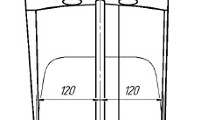The surface wear of a cylindrical mandrel during elongation rolling of 20Kh13 steel pipe in a MISiS-130D screw-rolling mill is studied. The dimensions of the mandrel were determined before and after the rolling. It is shown that after rolling five 72 × 9 mm hollow shells of 700 mm length, the diameter of the mandrel in the deformation zone decreased by 0.04 mm maximum. The material durability of the mandrel used was 28.5 ton/kg. The finite-element method was used to simulate the elongation rolling of shells into tubes on a short cylindrical mandrel. It was found out that the maximum wear is in the gorge zone, where the diameter dimensions of the mandrel decreased by 0.01 mm after each pass. The material durability of the mandrel decreased by 78.9% after five passes.






Similar content being viewed by others
References
A. V. Vydrin, “Developing the technologies of hot rolling of seamless tubes,” Chern. Metally, No. 9, 16–20 (2012).
S. V. Samusev, et al., “Shaping of pipe blanks on specialized bending equipment,” Steel in Transl., 46, No. 3, 169–172 (2016).
S. V. Samusev, et al., “Research of technological parameters of billet stepwise forming in production of large diameter tubes at tube electric pipe welded line TESA 1420,” Chern. Metally, No. 9, 73–77 (2017).
B. A. Romantsev, et al., “Development of multipass skew rolling technology for stainless steel and alloy pipes’ production,” Int. J. Adv. Manufact. Technol., 97, No. 9-12, 3223–3230 (2018).
B. A. Romantsev, et al., “Producing hot-rolled tubes from Kh18N10T steel in screw-rolling mills,” Proizv. Prokata, No. 8, 14–17 (2014).
A. V. Goncharuk, V. A. Fadeev, and M. V. Kadach, “Seamless pipes manufacturing process improvement using mandreling,” Solid State Phenomena, 316, 402–407 (2021).
B. A. Romantsev, et al., “Mini tube-production unit 40–80 with a three-high reeling mill,” Metallurgist, 55, No. 11–12, 918–924 (2012).
A. S. Aleshchenko, et al., “Wear features of working tools during piercing of high-temperature alloys,” Chern. Metally, 8, No. 8, 63–70 (2018).
D. A. Orlov, et al., “Development and investigation of piercing process using cooled guide shoes,” Metallurgist, 65, No. 3–4, 389–399 (2021).
A. A. Korsakov, et al., “Analysis of technology solutions intended to increase the durability of piercing mandrels,” Proizv. Prokata, No. 5, 27–35 (2012).
I. O. Sazonenko, et al., “Revisiting the issue of increasing the durability of piercing mandrels,” Lit’e Metallurg., No. 4 (68), 135–138 (2012).
B. A. Romantsev, et al., “Features of piercing mill TPA 50-200 working roll wear during rolling continuously-cast and hot-rolled billets,” Metallurgist, 60, No. 9–10, 1062–1069 (2017).
B. A. Romantsev, et al., “Features in the wear of the working rolls of TPA 159-426 piercing mill during rolling of continuously-cast billets of large diameter,” Proizv. Prokata, No. 6, 20–27 (2016).
K. Serin and H. J. Pehle, “Improved service life of hot working tools in seamless tube plants,” Stahl und Eisen, 134, No. 11, 161–174 (2014).
N. M. Vavilkin, et al., “Features of the wear of water-cooled mandrels when piercing alloyed steels,” Izv. VUZov: Chern. Metallurg., No. 7, 37–40 (2009).
N. M. Vavilkin, et al., “Studying the thermostressed state of water-cooled piercing mandrels,” Izv. VUZov: Chern. Metallurg., No. 9, 35–38 (2010).
A. Ramalho, M. Esteves, and P. Marta, “Friction, and wear behaviour of rolling-sliding steel contacts,” Wear, 302, No. 1–2, 1468–1480 (2013).
K. Min, et al., “Effects of oxide layers on surface defects during hot rolling processes,” Metals Mater. Int., 18, No. 2, 341–348 (2012).
M. Yu. Chubukov, et al., “Studying the influence of the technology of producing piercing mandrels on the structure of surface and internal oxide layers,” Chern. Metally, No. 1, 28–33 (2016).
M. S. Konovalov, “Selecting material, design, and manufacturing technique of mandrels for piercing corrosion-resistant steel billets,” Innovats. Nauka, No. 12-2, 70–73 (2015).
B. A. Romantsev, et al., “Improving the wear resistance of piercing-mill mandrels,” Steel in Transl., 38, No. 11, 897–899 (2008).
Yu. L. Gerasimov, S. V. Avdeev, and Yu. L. Bobarikin, “Studying the influence of features of the oxidized coating of piercing mandrels on their durability,” Chern. Metally, No. 7, 46–49 (2017).
G. Gevorgyan, et al., “Heat treatment of mandrel steel for pipes’ piercing,” J. Physics: Conf. Series, 1926, No. 1, 012039 (2021).
I. I. Lube, et al., “Increase of resistance of piercing mill mandrels at seamless pipes production of 13Cr grade martensite class stainless steel at line ТПА 159-426 of JSC VTZ,” Ferrous Metallurgy: Bul. Sci., Techn. Econom. Inform., 76, No. 12, 1259–1264 (2020).
M. Yu. Chubukov, et al., “Change in the surface oxide layer of piercing-mill mandrels over time,” Steel in Transl., 46, No. 11, 818–822 (2016).
A. V. Goncharuk et al., “Piercing of a billet in a mill with guide disks,” Russian Metallurgy (Metally), 2020, No. 13, 1637–1642 (2020).
Yu. V. Gamin, et al., “Prediction of billet fracture at two-high screw rolling piercing,” Metallurgist, 64, No. 9–10, 1020–1028 (2021).
A. S. Budnikov, et al., “Effect of plugless deformation in screw rolling three-roll mill on the change of tube wall thickness,” Chern. Metally, No. 12, 41–45 (2019).
A. Alimov, D. Evdokimov, and S. Evsyukov, “Temperature, and strain rate dependent friction model for hot forming of Ti-6Al-4V titanium alloy,” Mater. Today: Proc., No. 19, 1994–1997 (2019).
Author information
Authors and Affiliations
Corresponding author
Additional information
Translated from Metallurg, Vol. 66, No. 6, pp. 38–42, June, 2022. Russian DOI https://doi.org/10.52351/00260827_2022_06_38.
Rights and permissions
Springer Nature or its licensor holds exclusive rights to this article under a publishing agreement with the author(s) or other rightsholder(s); author self-archiving of the accepted manuscript version of this article is solely governed by the terms of such publishing agreement and applicable law.
About this article
Cite this article
Aleshchenko, A.S., Quang, N. Studying the Wear Resistance of the Mandrels of a Two-High Screw Rolling Mill. Metallurgist 66, 650–656 (2022). https://doi.org/10.1007/s11015-022-01372-5
Received:
Revised:
Accepted:
Published:
Issue Date:
DOI: https://doi.org/10.1007/s11015-022-01372-5




